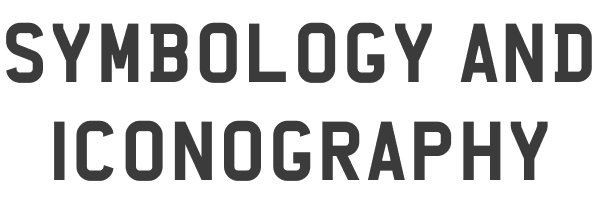- Manufacturer: Abiomed
- www.abiomed.com
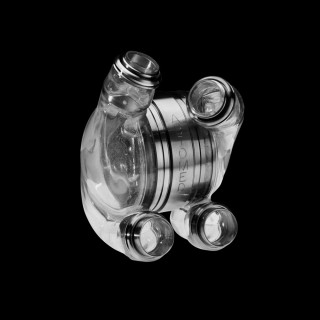
Index
- Abiomed Abiomed (NASDAQ: ABMD) is a global technology leader focused on recovering hearts and saving lives. The Company's portfolio of heart support and recov
- Heart Failure Your body depends on the heart's pumping action to deliver oxygen and nutrient-rich blood to the body's cells. When the cells are nourished properly,
- Replacement The earliest operations on the pericardium (the sac that surrounds the heart) took place in the 19th century and were performed by, Francisco Romero D
- Experimental Treatments 1800s Hawthorn (Crataegus species ) is a small tree or shrub and a member of the rose family. It was hung over the doorway in the Middle Ages to preve
- Symbology and Iconography The heart has long been used as a symbol to refer to the spiritual, emotional, moral, and in the past also intellectual core of a human being. As the
- Hearts in Music Heart of Glass - Blondie
Abiomed (NASDAQ: ABMD) is a global technology leader focused on recovering hearts and saving lives. The Company's portfolio of heart support and recovery products and services offer healthcare professionals an array of choices across a broad clinical spectrum. From the catheterization lab to the surgical suite, together with interventional cardiologists and surgeons, Abiomed is dedicated to providing the most advanced medical technologies to heart patients, with the ultimate goal of heart recovery and improved quality of life.
Abiomed was founded more than two decades ago and is the only company in the world with exclusive labeling on ventricular assist devices for all potentially recoverable heart failure indications. The company develops, manufactures and markets advanced medical technologies designed to assist or replace the pumping function of the failing heart. Abiomed is the global leader for products in the acute heart failure market and ships more ventricle assist devices (VADs) than any other company in the world.
The company is focused on expanding its global distribution, fueling innovation and new products to broaden the company's product portfolio to become the world's circulatory care leader.
Your body depends on the heart's pumping action to deliver oxygen and nutrient-rich blood to the body's cells. When the cells are nourished properly, the body can function normally. With heart failure, the weakened heart can't supply the cells with enough blood. This results in fatigue and shortness of breath. Everyday activities such as walking, climbing stairs or carrying groceries can become very difficult. Heart failure is a serious condition, and usually there's no cure. But many people with heart failure lead a full, enjoyable life when the condition is managed with medications and healthy lifestyle changes.
Heart transplantation
More than 700,000 Americans die each year from heart failure, making it the number one cause of death in the U.S., as well as worldwide. About half of these are sudden cardiac deaths, which occur so quickly that there is not enough time for intervention with a cardiac assist or replacement device. For the remaining half, heart transplantation is one of the few options available today. Though hundreds of thousands are in need, only about 2,000 people in the U.S. will be able to receive donor hearts every year. This consistent shortage in the supply of donor hearts in the U.S. demonstrates the need for an alternative to heart transplantation.
Causes
- Coronary artery disease and heart attack
- High Blood Pressure (hypertension)
- Faulty heart valves
- Damage to the heart muscle (cardiomyopathy)
- Myocarditis
- Heart defects present at birth (congential heart defects)
- Aboral hear rhythms (heart arrhythmias)
- Other diseases i.e Chronic diseases such as diabetes, severe anemia, hyperthyroidism, hypothyroidism, emphysema, lupus, hemochromatosis and amyloidosis also may contribute to heart failure.
Signs and Symptoms
- Shortness of breath or trouble breathing
- Fatigue (tiredness)
- Swelling in the ankles, feet, legs, abdomen, and, rarely, the veins in your neck
All of these symptoms are due to the buildup of fluid in your body. When symptoms start, you may feel tired and short of breath after routine physical effort—like climbing stairs.
As the heart grows weaker, symptoms get worse. You may begin to feel tired and short of breath after getting dressed or walking across the room. Some people have shortness of breath while lying flat.
Fluid buildup from heart failure also causes weight gain, frequent urination, and a cough that's worse at night and when you're lying down. This cough may be a sign of a condition called acute pulmonary (PULL-mun-ary) edema (e-DE-ma). This is when too much fluid is in your lungs. This severe condition requires emergency treatment.
The earliest operations on the pericardium (the sac that surrounds the heart) took place in the 19th century and were performed by, Francisco Romero Dominique Jean Larrey, Henry Dalton, and Daniel Hale Williams. The first surgery on the heart itself was performed by Norwegian surgeon Axel Cappelen on the 4th of september 1895 at Rikshospitalet in Kristiania, now Oslo. He ligated a bleeding coronary artery in a 24 year old man who had been stabbed in the left axillae and was in deep shock upon arrival. Access was through a left thoracotomy. The patient awoke and seemed fine for 24hrs, but became ill with increasing temperature and he ultimately died from what the post mortem proved to be mediastinitis on the 3rd postoperative day. The first successful surgery of the heart, performed without any complications, was by Dr. Ludwig Rehn of Frankfurt, Germany, who repaired a stab wound to the right ventricle on September 7, 1896.
AbioCor Replacement Heart
The AbioCor is the world's first completely self-contained replacement heart. A product of three decades of research, development and testing, the AbioCor is central to ABIOMED's mission to make real the day when heart failure need not mean the end of life or the ability to enjoy life. Designed to fully sustain the body's circulatory system, the AbioCor is intended for end-stage heart failure patients whose other treatment options have been exhausted. A rechargeable internal battery allows the patient to be completely free of the external power transmission unit for some period of time. Normally an external power pack transmits power across the skin.
Patients with an implanted AbioCor heart will still have atria that beat at the same time, but the artificial heart, which replaces both ventricles, can only force blood out one ventricle at a time. So, it will alternately send blood to the lungs and then to the body, instead of both at the same time as a natural heart does. The AbioCor is able to pump more than 10 liters per minute, which is enough for everyday activities.
The AbioCor is primarily made of titanium and Angioflex™, ABIOMED's proprietary polyether-based polyurethane plastic. Angioflex has been developed and tested by ABIOMED to be a dependable substance and safe for contact with blood. The AbioCor is designed to have relatively few moving parts. Moving parts such as the valves and hydraulic membranes are manufactured from Angioflex. Angioflex has proven flexible and durable enough to withstand beating 100,000 times a day (the approximate number of beats per day of the natural heart). The AbioCor's smooth plastic construction and unique design are specifically engineered to reduce the likelihood of damage to blood cells and to prevent clotting.
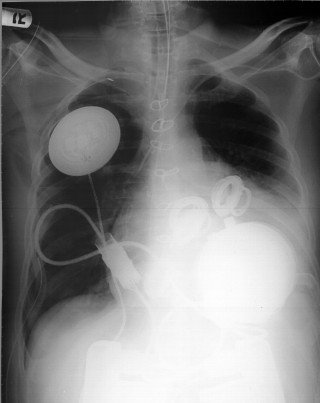
- www.abiomed.com/products/heart_replacement.cfm
- health.howstuffworks.com/artificial-heart1.htm
- www.abiomed.com/products/faqs.cfm
- www.roshanpakistan.com/web-magzine/Health/imgs/xray.jpg
How AbioCor works
The AbioCor System consists of the following implanted components:
- Replacement Heart
- Implanted TET
- Implanted Controller
- Implanted Battery
- Implanted Cable
In addition to the implanted components, the AbioCor System has external components that provide power to the AbioCor System.
Hydraulic pump - The basic idea with this device is similar to the hydraulic pumps used in heavy equipment. Force that is applied at one point is transmitted to another point using an incompressible fluid. A gear inside the pump spins at 10,000 revolutions per minute (rpm) to create pressure.
Porting valve - This valve opens and closes to let the hydraulic fluid flow from one side of the artificial heart to the other. When the fluid moves to the right, blood gets pumped to the lungs through an artificial ventricle. When the fluid moves to the left, blood gets pumped to the rest of the body.
Wireless energy-transfer system - Also called the Transcutaneous Energy Transfer (TET), this system consists of two coils, one internal and one external, that transmit power via magnetic force from an external battery across the skin without piercing the surface. The internal coil receives the power and sends it to the internal battery and controller device.
Internal battery - A rechargeable battery is implanted inside the patient's abdomen. This gives a patient 30 to 40 minutes to perform certain activities, such as showering, while disconnected from the main battery pack.
External battery - This battery is worn on a Velcro-belt pack around the patient's waist. Each rechargeable battery offers about four to five hours of power.
Controller - This small electronic device is implanted in the patient's abdominal wall. It monitors and controls the pumping speed of the heart.
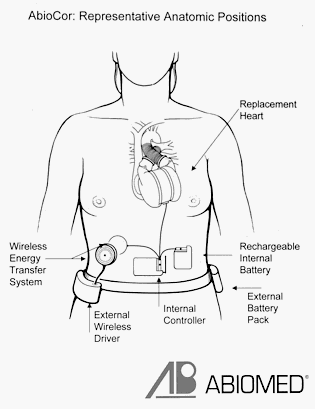
Procedure
1. Surgeons implant the energy-transfer coil in the abdomen.
2. The breast bone is opened and the patient is placed on a heart-lung machine.
3. Surgeons remove the right and left ventricles of the native heart. They leave in the right and left atria, the aorta and the pulmonary artery. This part of the surgery alone takes two to three hours.
4. Atrial cuffs are sewn to the native heart's right and left atria.
5. A plastic model is placed in the chest to determine the proper placement and fit of the heart in the patient.
6. Grafts are cut to an appropriate length and sewn to the aorta and pulmonary artery.
7. The AbioCor is placed in the chest. Surgeons use "quick connects" -- sort of like little snaps -- to connect the heart to the pulmonary artery, aorta and left and right atria.
8. All of the air in the device is removed.
9. The patient is taken off the heart-lung machine.
10. The surgical team ensures that the heart is working properly.
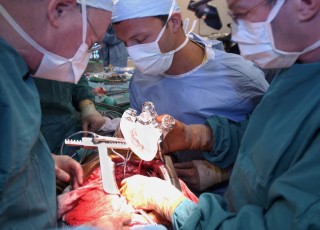
1800s
Hawthorn (Crataegus species ) is a small tree or shrub and a member of the rose family. It was hung over the doorway in the Middle Ages to prevent the entry of evil spirits. By the early 1800s, American doctors recognized the herb's medicinal properties and began using it to treat circulatory disorders and respiratory illnesses. Considered a "cardiotonic" herb or heart tonic, the flowers and berries of the hawthorn plant were used in traditional medicine to treat irregular heartbeat, high blood pressure, chest pain, hardening of the arteries, and heart failure. Hawthorn is commonly used to strengthen the heart.
Because of advances in suturing techniques at the end of the 19th century, surgeons began to transplant organs in their lab research.
- www.umm.edu/altmed/articles/hawthorn-000256.htm
- www.cumc.columbia.edu/dept/cs/pat/hearttx/history.html
1977
In 1977 Dr. Barnard developed a new approach to heart transplant surgery by piggy-backing ape hearts to the failing hearts of two patients. In one operation Dr. Barnard piggy-backed a baboon's heart and the patient died hours after the operation. In the other, he used a chimpanzee's heart; the patient died three and one-half days later.
But Dr. Barnard soon gave up on that approach because of the rejection phenomenon, saying that ''we will go ahead again'' when better antirejection drugs were developed. Dr. Barnard also said in an interview in 1978 that he abandoned the technique of using ape hearts in humans ''not because I'm so convinced I'm on the wrong track, but I got emotionally involved with the chimp.'
1984
In a bold surgical effort that could have a wide impact on the treatment of failing hearts, a 15-day-old girl received a baboon's heart in a five-hour operation Friday and was reported ''doing fine'' yesterday at Loma Linda University Medical Center in California.
Doctors attending the girl, who was described only as Baby Fae, said through a hospital spokesman that they were ''very pleased'' with the early postoperative results. However, they listed the baby in critical condition in the hospital's intensive care unit. That is standard for any patient who has undergone open-heart surgery.
While four earlier efforts to use ape hearts dating to 1964 all failed, this new effort comes when organ transplants are meeting with much greater success than ever before. The reasons for better success include a wider body of scientific knowledge as well as the development of improved tests to detect the rejection phenomenon and drugs to fight it since the first human- to-human heart transplant was done in 1967.
The heart has long been used as a symbol to refer to the spiritual, emotional, moral, and in the past also intellectual core of a human being. As the heart was once widely believed to be the seat of the human mind, the word heart continues to be used poetically to refer to the soul, and stylized depictions of hearts are extremely prevalent symbols representing love.
In Egyptian mythology, the heart portion of the soul was weighed in a balance against the feather of Ma'at, symbolising truth, in the judgment of the dead in the Egyptian Book of the Dead. Egyptian sources do not actually reveal whether the heart had to be lighter than the feather for the deceased to pass into paradise - all depictions show only the weighing of the heart, not the actual results, heavier or lighter.
Many classical philosophers and scientists, including Aristotle, considered the heart the seat of thought, reason or emotion, often rejecting the value of the brain.
Phrases
Have a heart - be merciful
Change of heart - change your mind
To know something by heart - memorize something
Broken heart - to lose love
Heartfelt - deeply felt
Have your heart in the right place - to be kind
Cry your heart out - to grieve
Heavy heart - sadness
Have your heart set on - to want something badly
Sacred Heart
The Sacred Heart (also known as Sacred Heart of Jesus) is one of the most famous religious devotions to Jesus's physical heart as the representation of His divine love for Humanity. This devotion is predominantly used in the Roman Catholic, Anglo Catholic, and Lutheran Churches. It stresses the central Christian concept of loving and adoring Jesus. The origin of this devotion in its modern form is derived from a French Roman Catholic nun, Marguerite Marie Alacoque, who said she learned the devotion from Jesus in visions.
In his encyclical Miserentissimus Redemptor, Pope Pius XI stated: "the spirit of expiation or reparation has always had the first and foremost place in the worship given to the Most Sacred Heart of Jesus".
- www.answers.com/topic/sacred-heart
- stclementshrine.org/assets/images/Sacred%20Heart%20of%20Jesus.jpg
I Love New York
In 1977, William S. Doyle, Deputy Commissioner of the New York State Department of Commerce hired advertising agency Wells Rich Greene to develop a marketing campaign for New York State. Doyle also recruited Milton Glaser, a productive graphic designer to work on the campaign, and created the design based on Wells Rich Greene's advertising campaign.
Glaser expected the campaign to last only a couple months and did the work pro bono. It was possibly inspired in part by the state tourism slogan Virginia is for Lovers which had featured a "Love" theme and red heart symbol (♥) since 1969.
The innovative pop-style icon became a major success and has continued to be sold for years. In the popular mind (though this was not the original intention) the logo has become closely associated with New York City, and the placement of the logo on plain white T-shirts readily sold in the city has widely circulated the appearance of the image, making it a commonly recognized symbol.
The symbol is the logo of the New York Heart Foundation. This charity provides funds to various groups working on cures for various diseases of the heart.
- en.wikipedia.org/wiki/I_Love_New_York
- s3.amazonaws.com/hypertextopia/public/uploads/3244/i-love-new-york.gif
Gaetano Pesce World Trade Center Lamp
BD: Were you there on September 11, 2001?
GP: No, I was in London. I was in a taxi going to the airport to come back to New York when I heard the news on the radio. There was no way to come back, so I stayed 11 days, I think. Afterward, I did an idea for an architectural proposal [for the World Trade Center site].
BD: The towers with the heart between them?
GP: Yes. Then I made a [similar] little lamp, a cabinet, and a carpet with the statement, "What we cannot make bigger, we can make small."
Valentine's Day
Valentine's Day or Saint Valentine's Day is a holiday celebrated on February 14 by many people throughout the world. In the English-speaking countries, it is the traditional day on which lovers express their love for each other by sending Valentine's cards, presenting flowers, or offering confectionery. The holiday is named after two among the numerous Early Christian martyrs named Valentine. The day became associated with romantic love in the circle of Geoffrey Chaucer in the High Middle Ages, when the tradition of courtly love flourished.
The day is most closely associated with the mutual exchange of love notes in the form of "valentines". Modern Valentine symbols include the heart-shaped outline.



























































































